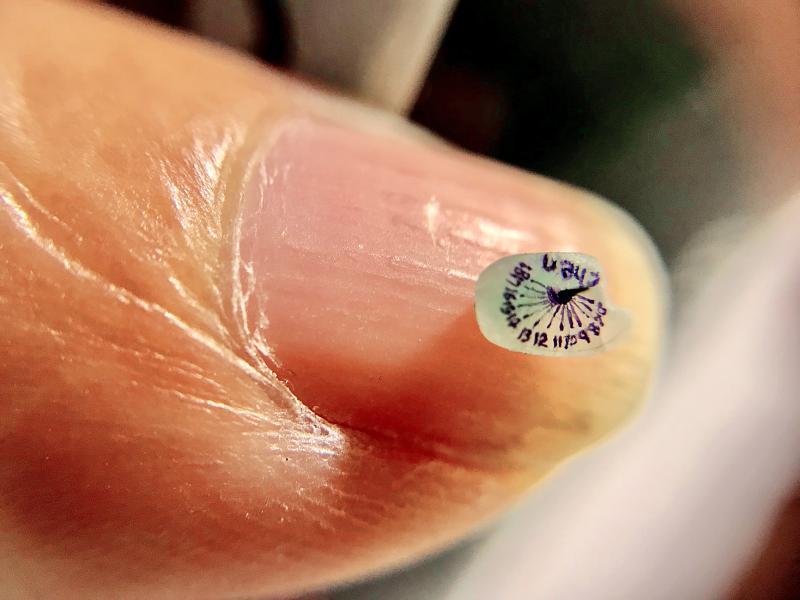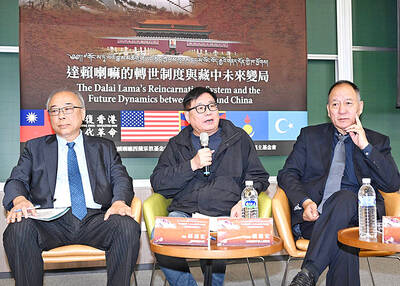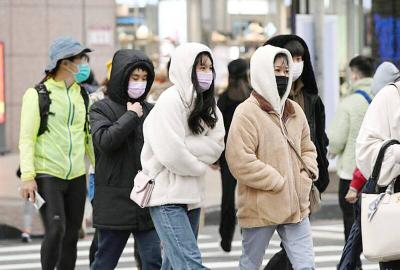Taiwanese miniature craftsman Chen Forng-shean (陳逢顯) has broken the Guinness World Record by making the world’s tiniest sundial from a grain of rice grown in Taiwan.
The French astronomical society had asked the French Office in Taipei to contact Chen and invite him to make a record-breaking sundial, which he completed after failing dozens of times.
The society provided Chen with information and photographs of the smallest sundial in the world — measuring 0.65cm by 0.5cm — that was created by an Italian in 1999.

Photo: Weng Yu-huang, Taipei Times
After a careful assessment, Chen told the society that he had no problem making a smaller sundial.
He used a grain of a type of Taiwanese rice to make the sundial, which, at 0.5cm by 0.3cm, set a new record.
A sundial is a device that uses the position of the sun to tell the time of day. The basic structure consists of a flat surface and a gnomon, which casts a shadow onto the dial.

Photo courtesy of Chen Forng-shean’s workshop
The shadow moves on the surface as the position of the sun changes and its tip aligns with different lines drawn on the surface to indicate the time.
A gnomon can be made from a wooden bar, a metal wire or a decorative sculpture, Chen said.
Chen said that the secret of making a sundial out of a rice grain lies in securing the position of the grain during the process.
He used tools such as a steel needle and writing brush to write tiny Arabic numbers from 6 to 18, covering the period between sunrise and sunset.
Chen said that with the help of a magnifying glass, he wrote the numbers and drew lines on the sundial while holding his breath.
The spacing of each number had to be carefully arranged since the rice grain was so small, he added.
Chen said he found the work meaningful because it was an act of people-to-people diplomacy.

ALIGNED THINKING: Taiwan and Japan have a mutual interest in trade, culture and engineering, and can work together for stability, Cho Jung-tai said Taiwan and Japan are two like-minded countries willing to work together to form a “safety barrier” in the Indo-Pacific region, Premier Cho Jung-tai (卓榮泰) yesterday said at the opening ceremony of the 35th Taiwan-Japan Modern Engineering and Technology Symposium in Taipei. Taiwan and Japan are close geographically and closer emotionally, he added. Citing the overflowing of a barrier lake in the Mataian River (馬太鞍溪) in September, Cho said the submersible water level sensors given by Japan during the disaster helped Taiwan monitor the lake’s water levels more accurately. Japan also provided a lot of vaccines early in the outbreak of the COVID-19 pandemic,

Kaohsiung Mayor Chen Chi-mai (陳其邁) on Monday announced light shows and themed traffic lights to welcome fans of South Korean pop group Twice to the port city. The group is to play Kaohsiung on Saturday as part of its “This Is For” world tour. It would be the group’s first performance in Taiwan since its debut 10 years ago. The all-female group consists of five South Koreans, three Japanese and Tainan’s Chou Tzu-yu (周子瑜), the first Taiwan-born and raised member of a South Korean girl group. To promote the group’s arrival, the city has been holding a series of events, including a pop-up

TEMPORAL/SPIRITUAL: Beijing’s claim that the next Buddhist leader must come from China is a heavy-handed political maneuver that will fall flat-faced, experts said China’s requirement that the Dalai Lama’s reincarnation to be born in China and approved by Beijing has drawn criticism, with experts at a forum in Taipei yesterday saying that if Beijing were to put forth its own Dalai Lama, the person would not be recognized by the Tibetan Buddhist community. The experts made a remarks at the two-day forum hosted by the Tibet Religious Foundation of His Holiness the Dalai Lama titled: “The Snow Land Forum: Finding Common Ground on Tibet.” China says it has the right to determine the Dalai Lama’s reincarnation, as it claims sovereignty over Tibet since ancient times,

Temperatures in some parts of Taiwan are expected to fall sharply to lows of 15°C later this week as seasonal northeasterly winds strengthen, the Central Weather Administration (CWA) said today. It is to be the strongest cold wave to affect northern Taiwan this autumn, while Chiayi County in the southwest and some parts of central Taiwan are likely to also see lower temperatures due to radiational cooling, which occurs under conditions of clear skies, light winds and dry weather, the CWA said. Across Taiwan, temperatures are to fall gradually this week, dropping to 15°C to 16°C in the early hours of Wednesday